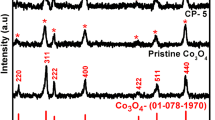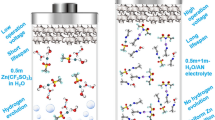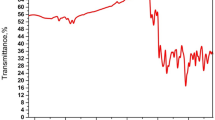Abstract
It has been recognized that conducting polymers could play a vital role as electrode material in supercapacitor application due to their high conductivity, fast charging, and discharging performance and ease of handling. Here, we prepared Ni2+-doped polyaniline (Ni-PANI) and polyaniline (PANI) films via oxidative chemical polymerization and studied their charge storage properties. A simple, inexpensive Successive Ionic Layer Adsorption and Reaction (SILAR) method was opted to grow composite material films on stainless steel conductor. The morphology and structural behaviour of prepared film electrodes were studied by FT-IR, XRD, and FESEM characterization techniques. The electrochemical properties of Ni-PANI and PANI were carried out in 1 M H2SO4 electrolyte using three-electrode system. Bare PANI showed the maximum specific capacitance of 667.5 F g−1 at current density of 5 mA cm−2. However, the doping of Ni2+ in PANI enhanced the specific capacitance to 1060 F g−1. In addition, this SILAR-synthesized binder-free Ni-PANI film showed good stability of 84% for 3000 CV cycles.






Similar content being viewed by others
Data Availability
Data will be made available on request.
References
P.A. Owusu, S. Asumadu-Sarkodie, A review of renewable energy sources, sustainability issues and climate change mitigation. Cogent Eng. 3, 1167990 (2016). https://doi.org/10.1080/23311916.2016.1167990
C. Wang, L. Zhang, Z. Zhang, R. Zhao, D. Zhao, R. Ma, L. Yin, Layered materials for supercapacitors and batteries: applications and challenges. Prog Mater. Sci. 118, 100763 (2021). https://doi.org/10.1016/j.pmatsci.2020.100763
G. Wang, L. Zhang, J. Zhang, A review of electrode materials for electrochemical supercapacitors. Chem. Soc. Rev. 41, 797–828 (2012). https://doi.org/10.1039/C1CS15060J
Z. Zhao, Y. Xie, Electrochemical supercapacitor performance of boron and nitrogen co-doped porous carbon nanowires. J. Power Sources. 400, 264–276 (2018). https://doi.org/10.1016/j.jpowsour.2018.08.032
L. Lu, Y. Xie, Phosphomolybdic acid cluster bridging carbon dots and polyaniline nanofibers for effective electrochemical energy storage. J. Mater. Sci. 54, 4842–4858 (2019). https://doi.org/10.1007/s10853-018-03185-x
I. Shown, A. Ganguly, L. Chen, K. Chen, Conducting polymer-based flexible supercapacitor. Energy Sci. Eng. 3, 2–26 (2015). https://doi.org/10.1002/ese3.50
H. Li, J. Wang, Q. Chu, Z. Wang, F. Zhang, S. Wang, Theoretical and experimental specific capacitance of polyaniline in sulfuric acid. J. Power Sources. 190, 578–586 (2009). https://doi.org/10.1016/j.jpowsour.2009.01.052
Q. Li, M. Horn, Y. Wang, J. MacLeod, N. Motta, J. Liu, A Review of Supercapacitors Based on Graphene and Redox-Active Organic Materials. Materials 12, 703 (2019). https://doi.org/10.3390/ma12050703
S. Shaheen Shah, S. Oladepo, M. Ali Ehsan, W. Iali, A. Alenaizan, M. Nahid Siddiqui, M. Oyama, A. Al-Betar, M.A. Aziz, Recent Progress in Polyaniline and its Composites for Supercapacitors. Chem. Rec. (2023). https://doi.org/10.1002/tcr.202300105
R. Vinodh, R.S. Babu, S. Sambasivam, C.V.V.M. Gopi, S. Alzahmi, H.-J. Kim, A.L.F. de Barros, I.M. Obaidat, Recent advancements of Polyaniline/Metal Organic Framework (PANI/MOF) composite electrodes for supercapacitor applications: a critical review. Nanomaterials 12, 1511 (2022). https://doi.org/10.3390/nano12091511
N. Çolak, B. Sökmen, Doping of chemically synthesized polyaniline. Des. Monomers Polym. 3, 181–189 (2000). https://doi.org/10.1163/156855500300142870
M.M. Rahman, T. Mahtab, M.Z. Bin Mukhlish, M.O. Faruk, M.M. Rahman, Enhancement of electrical properties of metal doped polyaniline synthesized by different doping techniques. Polym. Bull. 78, 5379–5397 (2021). https://doi.org/10.1007/s00289-020-03389-9
G. Karthikeyan, S. Sahoo, G.C. Nayak, C.K. Das, Doping effect of polyaniline/MWCNT composites on capacitance and cyclic stability of supercapacitors. J. Nanosci. Nanotechnol. 12, 2704–2710 (2012). https://doi.org/10.1166/jnn.2012.5715
S. Arulmani, J.J. Wu, S. Anandan, Ultrasound promoted transition metal doped polyaniline nanofibers: enhanced electrode material for electrochemical energy storage applications. Ultrason. Sonochem. 51, 469–477 (2019). https://doi.org/10.1016/j.ultsonch.2018.07.006
Y. Xie, X. Sha, Electrochemical cycling stability of nickel (II) coordinated polyaniline. Synth. Met. 237, 29–39 (2018). https://doi.org/10.1016/j.synthmet.2018.01.011
H. Xu, J. Li, Z. Peng, J. Zhuang, J. Zhang, Investigation of polyaniline films doped with Ni2+ as the electrode material for electrochemical supercapacitors. Electrochim. Acta. 90, 393–399 (2013). https://doi.org/10.1016/j.electacta.2012.12.047
S.M. Pawar, B.S. Pawar, J.H. Kim, O.-S. Joo, C.D. Lokhande, Recent status of chemical bath deposited metal chalcogenide and metal oxide thin films. Curr. Appl. Phys. 11, 117–161 (2011). https://doi.org/10.1016/j.cap.2010.07.007
H.M. Pathan, C.D. Lokhande, Deposition of metal chalcogenide thin films by successive ionic layer adsorption and reaction (SILAR) method. Bull. Mater. Sci. 27, 85–111 (2004). https://doi.org/10.1007/BF02708491
N.C. Maile, S.K. Shinde, K.S. Patil, A.V. Fulari, A. Shahzad, D.S. Lee, V.J. Fulari, Capacitive property studies of inexpensive SILAR synthesized polyaniline thin films for supercapacitor application. SN Appl. Sci. 1, 1333 (2019). https://doi.org/10.1007/s42452-019-1403-6
N.Y. Abu-Thabit, Chemical oxidative polymerization of Polyaniline: a practical Approach for Preparation of Smart Conductive textiles. J. Chem. Educ. 93, 1606–1611 (2016). https://doi.org/10.1021/acs.jchemed.6b00060
H. Xu, J. Tang, L. Tan, W. Wang, H. Lu, D. Guo, Synthesis and adsorption of Ni(II) on ni(II)-Imprinted Polyaniline supported on Attapulgite modified with 3-Methacryloxypropyltrimethoxysilane. Adsorpt. Sci. Technol. 31, 521–534 (2013). https://doi.org/10.1260/0263-6174.31.6.521
E. Yagudaeva, A. Vikhrov, Y. Malakhova, Y. Iskandyarova, M. Firsova, A. Prostyakova, A. Korovin, S. Malakhov, A. Nichugovskiy, V. Zubov, D. Kapustin, Tetramer of aniline as a structural analog of polyaniline – promising material for biomedical application. Synth. Met. 274, 116712 (2021). https://doi.org/10.1016/j.synthmet.2021.116712
D.P. Dubal, S.V. Patil, G.S. Gund, C.D. Lokhande, Polyaniline–polypyrrole nanograined composite via electrostatic adsorption for high performance electrochemical supercapacitors. J. Alloys Compd. 552, 240–247 (2013). https://doi.org/10.1016/j.jallcom.2012.10.031
D. Ghosh, S. Giri, A. Mandal, C.K. Das, Supercapacitor based on H+ and Ni2+ co-doped polyaniline–MWCNTs nanocomposite: synthesis and electrochemical characterization. RSC Adv. 3, 11676 (2013). https://doi.org/10.1039/c3ra40955d
I. Šeděnková, M. Trchová, J. Stejskal, Thermal degradation of polyaniline films prepared in solutions of strong and weak acids and in water – FTIR and Raman spectroscopic studies. Polym. Degrad. Stab. 93, 2147–2157 (2008). https://doi.org/10.1016/j.polymdegradstab.2008.08.007
S. Tao, B. Hong, Z. Kerong, An infrared and Raman spectroscopic study of polyanilines co-doped with metal ions and H+. Spectrochim Acta Part. Mol. Biomol. Spectrosc. 66, 1364–1368 (2007). https://doi.org/10.1016/j.saa.2006.08.011
Y.H. Kim, C. Foster, J. Chiang, A.J. Heeger, Localized charged excitations in polyaniline: infrared photoexcitation and protonation studies. Synth. Met. 29, 285–290 (1989). https://doi.org/10.1016/0379-6779(89)90308-1
T. Abdiryim, Z. Xiao-Gang, R. Jamal, Comparative studies of solid-state synthesized polyaniline doped with inorganic acids. Mater. Chem. Phys. 90, 367–372 (2005). https://doi.org/10.1016/j.matchemphys.2004.10.036
J. Li, M. Cui, Y. Lai, Z. Zhang, H. Lu, J. Fang, Y. Liu, Investigation of polyaniline co-doped with Zn2+ and H+ as the electrode material for electrochemical supercapacitors. Synth. Met. 160, 1228–1233 (2010). https://doi.org/10.1016/j.synthmet.2010.03.014
C. Yang, C. Chen, Synthesis, characterisation and properties of polyanilines containing transition metal ions. Synth. Met. 153, 133–136 (2005). https://doi.org/10.1016/j.synthmet.2005.07.136
P.R. Deshmukh, R.N. Bulakhe, S.N. Pusawale, S.D. Sartale, C.D. Lokhande, Polyaniline-RuO2 composite for high performance supercapacitors: Chemical synthesis and properties. RSC Adv. 5, 28687–28695 (2015). https://doi.org/10.1039/c4ra16969g
Y. Wang, X. Wu, W. Zhang, S. Huang, Facile synthesis of Ni/PANI/RGO composites and their excellent electromagnetic wave absorption properties. Synth. Met. 210, 165–170 (2015). https://doi.org/10.1016/j.synthmet.2015.09.022
Funding
The authors have not disclosed any funding.
Author information
Authors and Affiliations
Contributions
THB: Conceptualization, methodology, experiments, Writing—original draft, and review and editing. UMC: Performed the characterizations, interpreted the data and calculations, and drafted the manuscript. SSP: Experiments and data curation. JM: Conceptualization, data curation, and Writing—review and editing. VJF: Conceptualization, supervision, and resources.
Corresponding author
Ethics declarations
Competing Interests
Authors declare no conflict of interest.
Ethical approval
This study does not include any human participants.
Additional information
Publisher’s Note
Springer Nature remains neutral with regard to jurisdictional claims in published maps and institutional affiliations.
Rights and permissions
Springer Nature or its licensor (e.g. a society or other partner) holds exclusive rights to this article under a publishing agreement with the author(s) or other rightsholder(s); author self-archiving of the accepted manuscript version of this article is solely governed by the terms of such publishing agreement and applicable law.
About this article
Cite this article
Bajantri, T.H., Chougale, U.M., Patil, S.S. et al. Simple SILAR-synthesized Ni2+-doped polyaniline film for supercapacitor application. J Mater Sci: Mater Electron 35, 896 (2024). https://doi.org/10.1007/s10854-024-12434-6
Received:
Accepted:
Published:
DOI: https://doi.org/10.1007/s10854-024-12434-6




